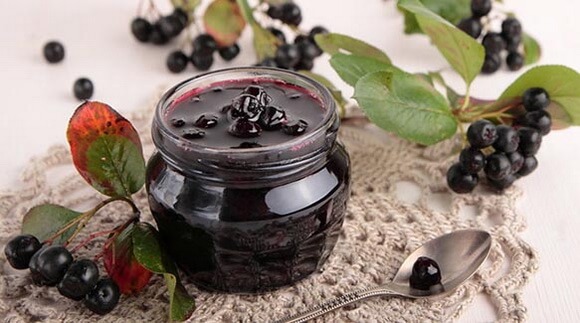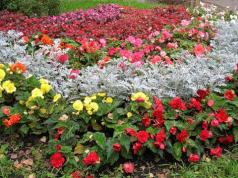Chokeberry(aka Chokeberry) has recently attracted the attention of fitness enthusiasts and nutritionists for its exceptional nutritional value.
This plant belongs to the Rosaceae family, which includes such varieties as red chokeberry and purple or Swedish mountain ash - a natural hybrid of the first two. Chokeberry bushes are most often found in wet forests and swamps. They reach a height of 3 m. The leaves of the chokeberry are elliptical and have graceful "denticles" at the edges, but they do not have any hairs or bristles.
Chokeberry
The fruits of the chokeberry are small (about 1 cm) with a relatively thick, pigmented shell. The red rowan berry tastes sweeter than the black variety. The latter seem slightly bitter. However, black and purple fruits are the most beneficial for the body, as they are the richest sources of anthocyanins (a class of antioxidants). Rowan berries usually ripen at the end of September and can be harvested for harvesting for the winter for about 2 more months. Unless, of course, the birds are ahead of you.
The benefits of chokeberry
Chokeberry is low in calories and fat. There are 47 calories in 100 g of fresh fruit.
The black color of the berries is due to the large amount of phenolic flavonoids - phytochemicals called anthocyanins (560 - 1050 mg / 100 g fresh weight). In addition to shielding the fruit from the sun's rays, anthocyanins contribute to their astringent taste.
In total, there are 1480 mg of anthocyanins per 100 g of fresh fruits,
The concentration of proanthocyanidin is 664 mg per 100 g.
Scientific studies have shown that consuming berries on a regular basis has anti-aging effects and may help prevent cancer, neurological diseases, inflammation, diabetes and bacterial infections.
Laboratory analysis of anthocyanins in chokeberry has identified the following individual chemicals:
cyanidin-3-galactoside;
quercetin;
peonidin;
delphinidine;
petunidine;
epicatechin;
caffeic acid;
pelargonidine;
malvidin.
These flavonoid polyphenolic antioxidants have proven health benefits through their ability to flush dangerous oxygen-free radicals out of the body.
However, the beneficial properties of chokeberry are not limited to this. Chokeberry preparations were first used to inhibit chemically induced esophageal cancer in rats. They reduced the severity of the disease by 30-60%, and the severity of colon cancer by 80%.
The medicinal properties of chokeberry were also effective in lowering sugar in experiments on diabetic rats. And in a 2002 study, a group of diabetic patients drank 200 ml of chokeberry juice every day for three months. The results showed that the subjects had decreased blood sugar levels.
Blackberry and blood pressure are linked, according to a 2010 study. It was attended by 25 people who suffered from metabolic syndrome, which contributes to high blood pressure and cholesterol levels. For 2 months, they ate 100 mg of chokeberry. The researchers noticed that the subjects' blood pressure and cholesterol levels dropped significantly at the end of the study.
If you are planning to lose weight after winter, chokeberry is an excellent choice. Its benefits lie in providing a balancing effect on the body. This plant has the ability to prevent the accumulation of fat in the body, especially in the abdominal area.
The fruits of this plant are also rich in flavonoid antioxidants such as carotene, lutein, and zeaxanthin. The latter has a photo-filtering effect on UV rays and thus protects the eyes from macular degeneration in the elderly.
Why is chokeberry useful? It is a natural source of many antioxidant vitamins such as:
vitamin C;
vitamin A;
vitamin E;
beta carotene;
folic acid;
and minerals:
potassium;
iron;
manganese;
Just 100 g of fresh berries provide about 35% of the daily vitamin C level.
Potential harm to chokeberry
Chokeberry contains oxalic acid, a naturally occurring substance found in some fruits and vegetables. It can crystallize as oxalates (stones) in the urinary tract in some people. Therefore, persons whose medical history has recorded the presence of oxalates in the urinary tract should not be prevented or treated with chokeberry. And when eating the fruits of chokeberry, it is advisable to drink a lot of water to maintain normal urine output.
Oxalic acid also prevents minerals such as calcium and magnesium from being absorbed.
Important: Children under the age of three are not recommended to add fresh or dried mountain ash to food, as well as its juice.
Storage and use of chokeberry
In the wild, chokeberries can be plucked from the bush and eaten immediately after a simple wash. When shopping for jam or preserves, choose berries that look fresh and have a shiny, clean surface. Throw away all wet and “spotted” fruits immediately, as they tend to spread mold to others.
Blackberries can be stored in the refrigerator for about a week. Wash them in cold water just before use.
The raw material of chokeberry is quite tough, so its fruits are usually eaten in processed form. Chokeberry juice can be added to fruit drinks and jellies.
As a food product, rowan juice is mixed with other juices, for example, apple, cranberry and grape juices. Chokeberry was originally grown in Russia for decorative purposes. Only since the 1940s, its benefits were fully appreciated and began to be used in juice products (mixed with apple juice), added to wines, compotes, tea and even pickles. And in Europe, its fruits are used to prepare food colors, juice, alcoholic drinks and energy drinks.
When planted in the country, chokeberry will attract beneficial insects. It can withstand periods of drought and can be used as a windbreak and a fruit-bearing hedge. Aronia is planted in spring or autumn. It does not tolerate shading, so the seedlings should be at least 2 meters apart. It is best planted in drainage lands.

Chokeberry jam
What to cook from chokeberry
- Aronia is a great addition to ice cream and fruit salads.
- Chokeberry is also used to make juices, jams, cakes, muffins, pies and baby food.
- Chokeberry wine is easy to make at home. This is done as follows: take 1 liter of rowan berries, 1 kg of sugar and 100 grams of raisins. If the berries are very dirty, they can be washed lightly. Otherwise, you do not need to wash the berries. Place the berries in a 3 liter jar, add 350 grams of sugar and unwashed raisins. Fill ¾ bottle with cold filtered water. Close the jar with a small opening and place in a warm and dark place. Stir the wine daily in a circular motion. Add 300 grams of sugar every 7 days for 2 weeks. The wine will ferment for a month. Then add the remaining sugar and wait for the fruit to settle to the bottom of the jar. Leave it on for another 14 days. After this period, the wine will be ready, it can be poured into a separate bowl.
- Berries can be frozen, while frozen chokeberry does not lose its beneficial properties. In winter, you can eat chokeberry raw, or cook compotes and jelly from it.
- To prepare 2 liters of mountain ash jam for the winter, you need to take 1 kg of berries and 1.5 kg of granulated sugar. Combine sugar with two cups of boiled water and bring to a boil over low heat. Pour chokeberry fruits into the resulting syrup and boil for 5 minutes. After that, you can lay out the chokeberry jam on pre-sterilized jars.
- To make mountain ash tea, mix dried chokeberry with equal amounts of rose hips. Pour a tablespoon of fruit with a glass of boiling water, leave for an hour. This tea can be drunk 2-3 times a day in order to support the immune system and prevent and treat atherosclerosis.








